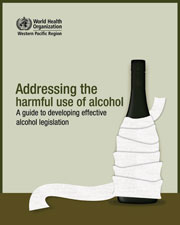
Alcohol kills more people globally than HIV/AIDS
The 2011 edition of the Global status report on alcohol and health confirms that alcohol is a major threat to global public health and welfare. Drinking alcohol kills more people than HIV/AIDS, tuberculosis or violence.

The full report and fact sheets for individual countries may be downloaded from the WHO web site.
Weak alcohol policies
In spite of the fact that a number of countries have taken initiatives to reduce alcohol-related harm, the report stresses that a wider implementation of policies is needed to save lives and reduce health impacts of harmful drinking. “Many countries have weak alcohol policies and prevention programs”, says WHO in a press comment to the report, 4 % of all deaths worldwide are attributed to alcohol, greater than deaths caused by HIV/AIDS, violence or tuberculosis.
Alcohol is also associated with many serious social issues, including violence, child neglect and abuse, as well as absenteeism in the workplace. “Yet, in spite of all these”, says the WHO report, “the harmful use of alcohol remains a low priority in public policy, including health policy. Many lesser health risks have higher priority.” “Clearly much more needs to be done to reduce the loss of life and suffering associated with harmful alcohol use,” said Dr Ala Alwan, WHO Assistant Director-General for Noncommunicable Diseases and Mental Health, in a comment at the launching event report in Geneva.
The new WHO Global Status Report provides comparable global information on the consumption of alcohol, the consequences of the harmful use of alcohol and the policy responses. Additionally it provides country profiles for more than 100 WHO Member States and a table of comparable alcohol consumption data from all countries.
High income – more drinking
The world’s highest alcohol consumption levels are found in the developed world, including Western and Eastern Europe. High-income countries generally have the highest alcohol consumption. However, it does not follow that high income and high consumption always translate into high alcohol-related problems and high-risk drinking. Western European countries have some of the highest consumption rates but their net alcohol-attributable mortality rates are relatively low, though their alcohol-related disease burden may be high.
A cause for concern, pointed out by the report, is the increase in alcohol consumption in Africa and South-East Asia from 2001-2005. Countries in the WHO Americas, European, Eastern Mediterranean and Western Pacific regions had relatively stable consumption levels during that time. Worldwide consumption in 2005 was equal to 6.13 litres of pure alcohol consumed per person aged 15 years or older. A large portion of this consumption – 28.6% or 1.76 litres per person – was homemade, illegally produced or sold outside normal government controls.
Increasing consumption in developing countries

More than half do not drink
The report rings a warning bell about the importance of the rate of non-drinkers globally and in individual populations: “Because abstention is so prevalent in the world, any diminution in abstention trends could have a big impact on the global burden of disease caused by the harmful use of alcohol.” Figures in the report show that, despite widespread consumption, a higher percentage of people currently do not drink at all. Almost half of all men and two thirds of women have not consumed alcohol in the past year.
“Abstention rates are low in high-income, high consumption countries, and higher in North African and South Asian countries with large Muslim populations. Female abstention rates are very high in these countries. Abstention from alcohol is very important in the global picture on alcohol consumption; it is one of the strongest predictors of the magnitude of alcohol-attributable burden of disease and injuries in populations. Obviously, lifetime abstention from alcohol means exemption from personal alcohol-attributable disease, injury and death”, says the report.
Something can be done!
The Global Status Report also looks at policy efforts in various countries around the world. It concludes by saying that “Contrary to the belief of many people, the health, safety and socioeconomic problems attributable to alcohol can be effectively reduced. Many evidence-based alcohol policies and prevention programmes are shown to work. One of the most effective is raising alcohol prices by raising taxes. This has the added benefit of generating increased revenues. A recent analysis of 112 studies on the effects of alcohol tax increases affirmed that when taxes go up, drinking goes down, including among problem drinkers and youth.”
Furthermore, the report points at implementing and enforcing legal drinking ages for the purchase and consumption of alcohol as another effective way to reduce alcohol-attributable problems. The same goes for the setting of maximum blood alcohol concentrations for drivers and enforcing them with sobriety checkpoints and random breath testing. These are effective and cost-effective ways to reduce alcohol-related traffic accidents.
Related articles
![]()
![]()
Developed with CustomPublish CMS by Nettinfo AS



